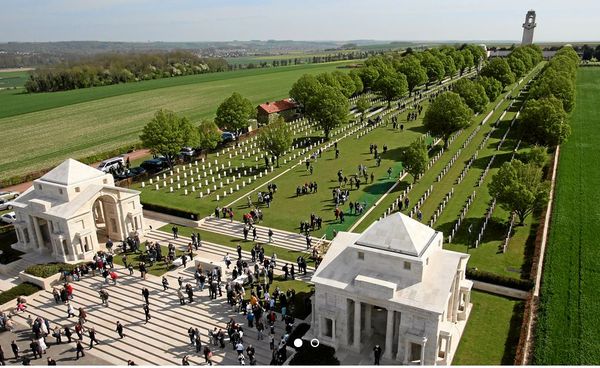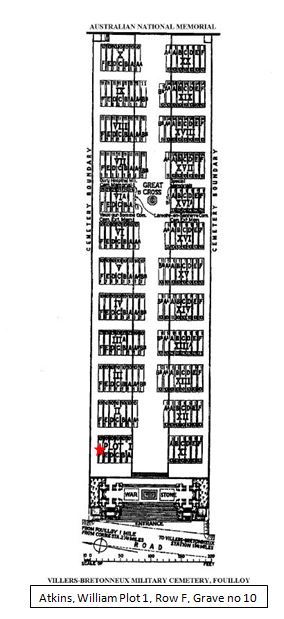William Atkins
From Our Contribution
 | |
| Personal Information | |
|---|---|
| Date of Birth | Apr 1885 |
| Place of Birth | Paddington, Sydney, New South Wales |
| Death | 4 Jul 1918 |
| Place of Death | Hamel, France |
| Age at Enlistment | 31 years, 1 month |
| Description |
5'7" (1.70m) tall ; 133 lbs 60.328 kg ; fresh complexion ; brown eyes ; dark brown hair |
| Occupation | Labourer |
| Religion | Methodist |
| Address | NOK c/- Victoria Park Post Office |
| Next of Kin | Wife , Mrs Nancy Jane Atkins |
| Military Information | |
| Reg Number | 2530 |
| Date of Enlistment | 30 May 1916 |
| Rank | Private |
| Unit/Formation | 44th Battalion, 5th Reinforcement allocated to 1 Platoon, A Company |
| Date of Embarkation | 9 Nov 1916 ‒ 10 Jan 1917 |
| Ship Embarked On | HMAT A8 Argyllshire |
| Fate |
Wounded in Action 4 Oct 1917 Killed in Action 4 Jul 1918 |
| Monument |
Banjup War Memorial Victoria Park Memorial |
| Medals |
British War Medal Victory Medal |
Contents
Pre War
During 1913 Bill married Nancy Jane Godenzi in Fremantle.
Nancy was born in Maldon, Victoria on 4 Jun 1877 and died in Esperance on 20 Aug 1946. Nancy had married Frederick Jacques in Bunbury during 1904 and they had a son Ernest (1904 - 1905), a daughter Evelyn Violet (1905 - 1905); and a son Frederick (1905 - 1911). Husband Frederick, and children had all died in Mornington Mills.
Bill and Nancy had a son Frederick William born 23 Feb 1914. Nancy remarried a third time in 1925 to Patrick Francis Sullivan (1892 - 1960).
War Service
Bill entered Blackboy Hill camp on 13 Jun 1916, and on 1 Aug 1916 he was assigned to the 6th reinforcement draft for the 44th Battalion. Obviously his training went well as on 4 Sep 1916 he was reallocated to the 5th reinforcement draft, and he embarked with them in Fremantle on the HMAT A8 Argyllshire on 9 Nov 1916, disembarking in Devonport, England, on 10 Jan 1917. On their arrival they were sent to the 11th Training Battalion at Larkhill on the Salisbury Plain to prepare for service on the Western Front. On 4 Mar 1917 he was admitted to Fargo Military Hospital with mumps before being discharged healthy on 10 May 1917, returning to the 11th Training Battalion. Bill proceeded overseas to France, on 16 July 1917 through Southampton and on arrival he marched into the 3rd Australian Divisional Base Depot, Le Havre, on 17 July 1917.
Evacuated to hospital on 24 July 1917 when he was admitted to the (British) 2nd General Hospital, Le Havre on 24 July 1917 with a sprained right knee. Discharged on 10 August 1917, he marched into 3rd Australian Divisional Base Depot, Le Havre, the same day. Bill proceeded to join the 44th Battalion on 24 August 1917, and was taken on strength of 44th Battalion as they moved to the rear midway between the coast and Hazebrouck on 26 August 1917.
Wounded in action on 4 October 1917 during the battalion's advance in what became known as the Battle for Broodseinde, he was admitted to the 44th Casualty Clearing Station with a shrapnel wound, left shoulder. Passed on to No 2 Canadian General Hospital on 5 October 1917, he was released to No 3 Convalescent Depot, Boulogne, on 12 October 1917 and finally discharged to duty with the 3rd Australian Divisional Base Depot, Rouelles, on 18 October 1917. Bill rejoined the 44th Battalion on 30 October 1917 at Saint Pierre, France where they were resting and rebuilding after their involvement in Passchedaele.
Granted leave to the United Kingdom on 6 February 1918 he rejoined the battalion on 23 February 1918 at Nieppe on the French - Belgium border where they were parading in front of General Birdwood. The early part of March 1918 was spent in the front lines near Nieppe before they again spent time in the rear near Lettinghem, remaining there, training and rebuilding, until late March when they were moved south to the Somme Valley where the Germans had broken through British lines and were seeking to capture Amiens. Initially placed in the line in the Heilly - Corbie sector, they then advanced on 28 Mar 1918 to meet the oncoming German forces, north of the Somme River. On 30 Mar 1918 they were all in action, and they remained in the line for the next week, before rotating in and out of the line north of the Somme. In May they moved south of the Somme and took up positions in the front line near Villers-Bretonneux, before moving back to prepare for the next attach - Hamel.
Bill was killed in action on 4 July 1918 when he and his battalion were part of the very successful Battle for Hamel. The 44th Battalion's objective was a line of trenches on a rise above the town and they succeeded with very few losses, but when the German's counter attacked that night, they suffered most of their 35 KIA, 150 wounded and 4 POW losses for the action.
2572 Pte JT Gregan described how Bill was killed: "On the morning of July 4th, some time before dinner, we were digging in after advancing in the neighbourhood of Hamel on the Somme, when Atkins, who was only about 50 yards along the trench from me, was instantaneously killed by a shell. He was the only man in the Company (A COY, 1 Platoon) killed at that time. His body was removed at night by the stretcher bearers but I do not know where he was buried. The Germans never regained the ground. Atkins and I came over in the same boat - the Argyllshire - which left Australia 9.11.16, and I knew him well as I was in the same Coy with him all the time afterwards, except for when I was in hospital. He was married.
Other different versions of his death are included in the Red Cross Files held by the Australian War Memorial, but this was the only eye witness version. One describes him as being from Jandakot, another from Cottesloe Beach, and another from Fremantle. Another version from 3621 LCpl H. Brown described how he was acting as a Lewis Gunner when hit by a German stick bomb when they were attacked by the Germans about 10pm the night of 4 Jul 1918.[1]

